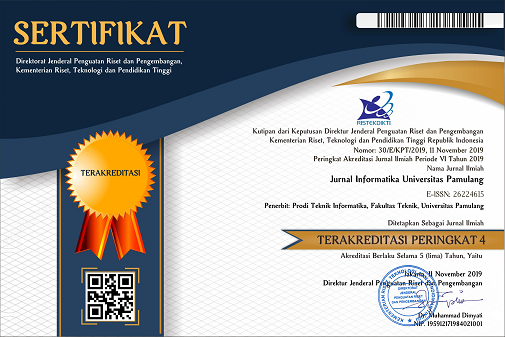Prediksi Penambahan Kasus Covid-19 di Indonesia Melalui Pendekatan Time Series Menggunakan Metode Exponential Smoothing
DOI:
https://doi.org/10.32493/informatika.v6i1.9442Keywords:
Covid-19, prediction, time series forecasting, exponential smoothingAbstract
The Covid-19 pandemic in Indonesia has emerged starting in 2020. To know the development of cases, a good calculation is needed. A prediction system can help in analyzing accurate data on positive causes, cures, and deaths. The right prediction or forecast can be the answer to the question of the impact that will occur, forecasting will provide an overview to the government and the community so that it is hoped that related parties can prepare for future impacts or even reduce the number of cases growth. In this study, the Exponential Smoothing method was used as a prediction calculation. This method is simple but effective in producing accurate predictions. Forecasting data used comes from the Indonesian government with the assumption that the data is valid and reliable. Based on research that has been carried out to predict the increase in new cases of the Indonesian National Covid-19, the best alpha (α) value is 0.33 with an SSE of 1048027,939. This shows that the number of cases is increasing. The results of forecasting in this study using the time series approach and the SES method are more suitable for predicting the percentage increase in cases than knowing the exact number.
References
Baharaeen, S., & Masud, A. S. (1986). A computer program for time series forecasting using single and double exponential smoothing techniques. Computers & Industrial Engineering, 11(1–4), 151–155. https://doi.org/10.1016/0360-8352(86)90068-9
Heizer, J., & Render, B. (2011). Operations Management. Pearson Education Inc.
Koesmawardhani, N. W. (2020). Pemerintah Tetapkan Masa Darurat Bencana Corona hingga 29 Mei 2020. Detik.Com. https://news.detik.com/berita/d-4942327/pemerintah-tetapkan-masa-darurat-bencana-corona-hingga-29-mei-2020
Liantoni, F., & Agusti, A. (2020). Forecasting Bitcoin using Double Exponential Smoothing Method Based on Mean Absolute Percentage Error. JOIV : International Journal on Informatics Visualization, 4(2), 91–95. https://doi.org/10.30630/joiv.4.2.335
Liu, M., Ning, J., Du, Y., Cao, J., Zhang, D., Wang, J., & Chen, M. (2020). Modelling the evolution trajectory of COVID-19 in Wuhan, China: experience and suggestions. Public Health, 183, 76–80. https://doi.org/10.1016/j.puhe.2020.05.001
Mona, N. (2020). Konsep Isolasi Dalam Jaringan Sosial Untuk Meminimalisasi Efek Contagious (Kasus Penyebaran Virus Corona Di Indonesia). Jurnal Sosial Humaniora Terapan, 2(2). https://doi.org/10.7454/JSHT.V2I2.86
Montgomery, D. C. (n.d.). Introduction to Time Series Analysis and Forecasting. Hoboken, New Jersey: John Wiley & Sons.
Parhusip, H. A. (2020). Study on COVID-19 in the World and Indonesia Using Regression Model of SVM, Bayesian Ridge and Gaussian. JURNAL ILMIAH SAINS, 20(2), 49. https://doi.org/10.35799/jis.20.2.2020.28256
Rosas, A. L., & Guerrero, V. M. (1994). Restricted forecasts using exponential smoothing techniques. International Journal of Forecasting, 10(4), 515–527. https://doi.org/10.1016/0169-2070(94)90020-5
Rosmha Widiyani. (2020, March 18). Latar Belakang Virus Corona, Perkembangan hingga Isu Terkini. https://news.detik.com/berita/d-4943950/latar-belakang-virus-corona-perkembangan-hingga-isu-terkini
Rusyida, W. Y., & Pratama, V. Y. (2020). Prediksi Harga Saham Garuda Indonesia di Tengah Pandemi Covid-19 Menggunakan Metode ARIMA. Square : Journal of Mathematics and Mathematics Education, 2(1), 73. https://doi.org/10.21580/square.2020.2.1.5626
UNS. (2020). Buku Saku KKN Relawan COVID 19. LPPM UNS.
Yuliana, Y. (2020). Corona virus diseases (Covid-19). Wellness And Healthy Magazine, 2(1), 187–192. https://wellness.journalpress.id/wellness/article/view/21026
Zhang, J., Wang, X., Wang, G., & Dong, W. (2020). Risk factors for disease severity, unimprovement, and mortality in COVID-19 patients in Wuhan, China. Clinical Microbiology and Infection, 26(6), 767–772. https://doi.org/10.1016/j.cmi.2020.04.012
Downloads
Published
Issue
Section
License
Authors who publish with this journal agree to the following terms:
- Authors retain copyright and grant the journal right of first publication with the work simultaneously licensed under a Creative Commons Attribution-NonCommercial 4.0 International (CC BY-NC 4.0) that allows others to share the work with an acknowledgement of the work's authorship and initial publication in this journal.
- Authors are able to enter into separate, additional contractual arrangements for the non-exclusive distribution of the journal's published version of the work (e.g., post it to an institutional repository or publish it in a book), with an acknowledgement of its initial publication in this journal.
- Authors are permitted and encouraged to post their work online (e.g., in institutional repositories or on their website) prior to and during the submission process, as it can lead to productive exchanges, as well as earlier and greater citation of published work (See The Effect of Open Access).
Jurnal Informatika Universitas Pamulang have CC-BY-NC or an equivalent license as the optimal license for the publication, distribution, use, and reuse of scholarly work.
In developing strategy and setting priorities, Jurnal Informatika Universitas Pamulang recognize that free access is better than priced access, libre access is better than free access, and libre under CC-BY-NC or the equivalent is better than libre under more restrictive open licenses. We should achieve what we can when we can. We should not delay achieving free in order to achieve libre, and we should not stop with free when we can achieve libre.
Jurnal Informatika Universitas Pamulang is licensed under a Creative Commons Attribution-NonCommercial 4.0 International (CC BY-NC 4.0)
YOU ARE FREE TO:
- Share : copy and redistribute the material in any medium or format
- Adapt : remix, transform, and build upon the material for any purpose, even commercially.
- The licensor cannot revoke these freedoms as long as you follow the license terms





